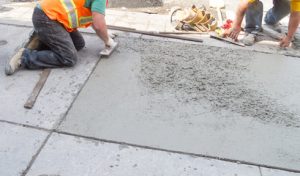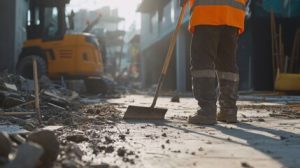Concrete Franklin TN is a versatile construction material that’s used in a variety of commercial paving and large scale building projects. Using specialist ingredients, concrete can withstand a wide range of weather conditions and abrasive chemicals.

Concrete is a combination of aggregates (usually crushed stone, gravel or pea-gravel) bound together with a hydraulic binder like Portland cement. The proportion of these ingredients can significantly affect the strength and durability of concrete.
Concrete is an incredibly durable and strong construction material. Its main components are cement and aggregate, which are combined to form a thick paste. The ingredients are then poured into molds to create different shapes, and once set, concrete is very resistant to damage from weather, stains and other environmental factors. Concrete’s strength is one of its primary benefits, making it a popular choice for projects that require large loads or high amounts of pressure.
To increase the strength of a concrete mix, contractors often add steel reinforcement bars or meshes within it. These additions not only boost the overall strength of the mixture, but also help it withstand bending and tensile stress that could otherwise cause it to crack or break. Reinforced concrete is commonly used in bridges, skyscrapers and other load-bearing buildings. It is also a popular choice for paving major roads and highways, commercial parking lots, sidewalks and recreational courts like pickleball or tennis.
Despite its enormous strength, concrete is still vulnerable to corrosion, which can weaken its structure and compromise its safety. To prevent this, concrete is regularly treated with chemicals to protect it from water, salt and other environmental contaminants. This treatment helps prevent chemical erosion, as well as sulfate and chloride contamination which can diminish its strength.
While concrete is very strong in compression, it’s not as good in tension, meaning that it will crack or snap if pulled or bent. However, this weakness can be mitigated by adding reinforcement and using a stronger mix design.
The strength of concrete is measured with a concrete cube or cylinder test, conducted by civil engineers at the construction site. This testing process determines the concrete’s compressive strength, which is presented in a chart based on its mix proportions. A higher mix proportion yields a stronger concrete, but this isn’t always feasible due to logistics and cost considerations. To ensure consistency, some builders opt for precast concrete, which is poured into forms and ready for use on site. This method reduces labor costs and speeds up project completion time.
Durability
Concrete is the foundation of many structures around the world. It is a material that stands up to heavy loads and extreme conditions without breaking down or cracking. This durability translates into lower maintenance costs and extended service life for the structures it supports, making it a cost-effective choice for many projects.
Concrete also resists corrosion, especially when it is reinforced with steel. This quality makes it a popular construction material for bridges and other load-bearing structures. It is also used for non-load bearing applications such as flooring and paving, as well as in water systems including drains, sewers and water tanks.
One of the most significant factors contributing to concrete durability is its inability to rot or be eaten by termites and other pests. Its inherent strength also prevents damage from fire and provides a barrier against moisture and humidity, which are common causes of structural failures.
In addition to these natural advantages, modern concrete materials are crafted with additives that enhance its durability even further. For example, air entrainment is incorporated into the mixture to provide microscopic air pockets that relieve internal pressure during freeze-thaw cycles. This feature, coupled with proper curing practices, improves the durability of concrete in cold climates by preventing a brittle, flaky structure that could crack under stress.
The use of recycled materials also contributes to concrete’s durability. By utilizing fly ash and slag as substitutes for cement, we reduce carbon emissions and increase the overall sustainability of the concrete mix. These materials are often supplemented with chemical admixtures that offer additional benefits to the concrete such as reduced water usage and higher strength at lower temperatures.
The durability of concrete is further enhanced by regular inspections and maintenance. These regular inspections help identify potential issues and address them before they can deteriorate further, saving money and extending the service life of the structure. Moreover, adhering to construction standards helps ensure that the concrete is of the highest possible quality.
Reliability
Concrete is a critical component of modern infrastructure, from skyscrapers and stadiums to bridges and dams. Ensuring that these structures are reliable is vital for their safety, economic viability and environmental sustainability. This can be accomplished by using a reliability-focused approach to structural design and assessment. This approach can help engineers manage uncertainty in the material properties, loads and environmental conditions that affect the reliability of concrete structures.
The central safety factor engineers use to guarantee a tolerable risk of structural failure is the ratio of the structure’s average load capacity to its average applied load. This factor is determined from a series of tests or numerical simulations on sample structures. However, these tests and simulations only cover a small part of the actual structure’s lifetime. To ensure the tolerable risk of failure, engineers must extrapolate these results to the actual structure’s entire lifecycle. This process is called structural reliability analysis, and it can be conducted using a range of advanced techniques.
One of the most important challenges in reliability-based design is understanding and quantifying material variability. This variation influences the mechanical properties and durability of concrete, and can have a major impact on the structural performance and lifespan of a building or bridge. To address this challenge, engineers are using advanced probabilistic methods in the design and assessment of concrete structures. These methods, such as Monte Carlo simulations and the First-Order Reliability Method (FORM), enable the accurate modeling of uncertainties in structural performance.
Another key challenge in reliability-based design is incorporating advancements in concrete materials and technology into the existing framework of structural assessment and design. These advancements can improve the reliability of existing concrete structures, as well as help engineers create more durable and sustainable future structures. For example, sensor technologies and monitoring can provide real-time data about the performance of concrete structures, allowing engineers to update their models based on actual performance. This will allow them to improve the structural resilience of future buildings and bridges.
In addition to its strength and durability, concrete is also highly versatile. It is used in a wide variety of applications, from radiation resistance to medical vaults and containment structures for nuclear power plants. Its versatility makes it a popular choice in industrial and commercial projects.
Sustainability
Concrete is an excellent choice for green construction projects. Its long lifespan means fewer repairs and replacements, minimizing environmental impact over time. In addition, it is fire-resistant, making it an excellent choice for buildings in areas prone to wildfires or other natural disasters. It is also resistant to pests and rot, which reduces maintenance costs over the course of a building’s life.
Additionally, concrete components are typically cast to precise specifications, reducing waste produced in the manufacturing process. Many steel and concrete plants have instituted water-recycling programs and other environmentally friendly processes to further lower their manufacturing footprint. Additionally, concrete’s thermal mass properties make it a sustainable building material for energy conservation. It can store and release heat to regulate interior temperatures, allowing for a more energy-efficient building that requires less heating and cooling throughout the day.
Moreover, concrete is often made with locally available materials and cast close to the project site, minimizing transportation costs. Typical concrete mix designs incorporate industrial byproducts such as fly ash, ground granulated blast furnace slag, silica fume and other alternative cementitious materials to reduce the amount of virgin materials required in the production process. Concrete can even be recycled after its service life has ended and repurposed into new structures.
For these reasons, concrete is an ideal material for roads and highways, commercial parking lots, walkways and pathways, and bridges. Its compressive strength and durability allow it to withstand the high traffic volumes, heavy loads and harsh environmental conditions of these environments. Its longevity makes it an ideal choice for dams and other large infrastructure projects, as well as recreational courts such as tennis or pickleball.
Concrete has a low environmental impact, as it is made with natural, readily-available materials that are highly durable. In addition, its long lifespan and low maintenance requirements reduces the need for repairs and replacements, resulting in significant savings in energy, water, and other resources used to maintain it.
Lastly, concrete’s sustainability is further enhanced by its ability to absorb carbon dioxide through a natural process called carbonation. This enables it to offset up to 43% of the calcination emissions that occur during cement production.




